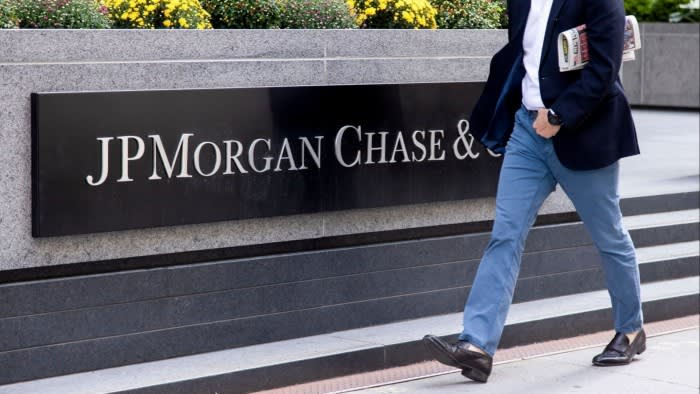Stay informed with free updates
Simply sign up to the US banks myFT Digest — delivered directly to your inbox.
US bank stocks hit their highest level since before the collapse of Silicon Valley Bank on Friday as better than expected profits from JPMorgan Chase and Wells Fargo boosted hopes of an economic “soft landing” in the country.
Quarterly earnings fell at both the largest and fourth-largest US banks by assets, compared with a year earlier. Third-quarter net income at JPMorgan declined 2 per cent to $12.9bn, while at Wells it fell 11 per cent to $5.1bn.
However analysts had forecast that JPMorgan would report quarterly net income of $12.1bn and Wells $4.5bn. JPMorgan’s shares rose 4.4 per cent in New York on Friday, while Wells’ gained 5.6 per cent.
The KBW bank index, which tracks 24 of the country’s biggest lenders, jumped more than 3 per cent, pushing the sector past its most recent high in February 2023, before the onset of the US regional banking crisis, and to its highest close since April 2022.
The earnings from JPMorgan and Wells are the latest sign that the Federal Reserve may have been able to tackle inflation without tipping the economy into recession: a so-called soft landing.
The Fed raised rates rapidly starting in 2022 in a bid to tame inflation, but markets had become increasingly concerned about the health of the US economy, and last month the Fed cut benchmark interest rates for the first time.
JPMorgan chief financial officer Jeremy Barnum said: “I would say these earnings are consistent with the soft landing narrative — or arguably what is increasingly a no landing narrative.”
Consumers had reduced spending on things such as travel and entertainment, Barnum added, but changes were “in the realm of what is normal, rather than indicative of actual unusual levels of stress in the consumer”.
Wells’ chief executive Charlie Scharf said: “We continue to look for changes in consumer health — but we do not see them. Spending continues on credit cards and debit cards. It’s slowing but still healthy.”
The strain on lower income Americans from higher prices did not appear to have spread to other parts of the economy, Wells’ chief financial officer Michael Santomassimo added.
However, Santomassimo said that Wells had yet to see any economic benefit from the rate cut, and that corporate borrowers remained cautious.
After driving profits for much of the past two years, banks’ profits from lending — so-called net interest income — is expected to come under pressure from falling US interest rates.
JPMorgan reported NII of $23.5bn in the latest quarter, up 3 per cent from a year earlier.
Wells said that NII would be worse than previously expected for the final quarter of this year, but lifted its outlook for 2025.
In contrast, JPMorgan raised its guidance for NII in 2024 to about $92.5bn — from $91bn — but did not provide an outlook for 2025 despite one of its most senior executives warning last month that analysts were too optimistic about NII for next year.
But JPMorgan chief executive Jamie Dimon appeared frustrated on Friday with repeated questions from analysts about the bank’s NII outlook.
“Next time, let’s just give them the damn number,” he said. “I don’t want to spend all the time in these calls going through what they’re guessing what NII is going to be next year.”
JPMorgan also reported better than expected figures for its investment bank. Investment banking fees were up by almost a third to $2.3bn, while revenues from equity trading were up more than a quarter to $2.6bn and fixed income trading revenues were flat at $4.5bn.
Bank of America, Citigroup and Goldman Sachs publish their results on October 15. Morgan Stanley reports the following day.
Additional reporting by Zehra Munir
https://www.ft.com/content/a2da4acc-1155-42de-b9cd-83980c007b61


